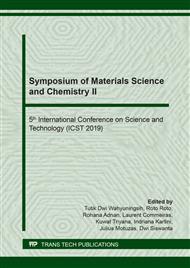p.270
p.277
p.284
p.293
p.300
p.305
p.311
p.318
p.324
Compressive Strength of Dental E-Glass Microfiber-Reinforced Composite Resin in Mouthwash Immersion
Abstract:
Fiber-reinforced composite resin (FRC) is gaining popularity as dental filling material. In the oral cavity, it will contact with the oral environment including oral cleansing agents. This research was aimed to determine the effect of mouthwash on the compressive strength of FRC. The materials used were E-glass FRC (EverX Posterior, GC Corp, Japan), alcohol mouthwash (Original Listerine, Johnson&Johnson, Indonesia), alcohol-free mouthwash (Listerine Cool Mint Zero, Johnson&Johnson, Indonesia). Forty-five FRCs were made in cylindrical shapes. Specimens were divided into 2 groups of mouthwash immersion: alcohol and alcohol-free mouthwash. The groups were sub-grouped by 0, 6, 12, and 24 h immersion. Samples were recorded for compressive strength by Universal Testing Machine. The data were analyzed by ANOVA. The result of compressive strength values (MPa) were (alcohol mouthwash): 293.59±30.54 (0 h), 284.43±46.91 (6 h), 268.71±44.66 (12 h), 252.19±31.49 (24 h); (alcohol-free mouthwash): 294.12±28.17 (0 h), 287.30±35.56 (6 h), 273.32±41.94 (12 h), 260.82±40.67 (24 h). Statistical analysis revealed there was no significant influence of mouthwash type (alcohol or alcohol-free mouthwash), immersion duration (0, 6, 12, 24 h), and combination of mouthwash type and immersion duration (p>0.05) to the compressive strength of FRCs. The conclusions were the mouthwash types, immersion duration, and combination of mouthwash type and immersion duration did not influence the compressive strength of E-glass FRC
Info:
Periodical:
Pages:
300-304
Citation:
Online since:
April 2020
Authors:
Price:
Сopyright:
© 2020 Trans Tech Publications Ltd. All Rights Reserved
Share:
Citation:


